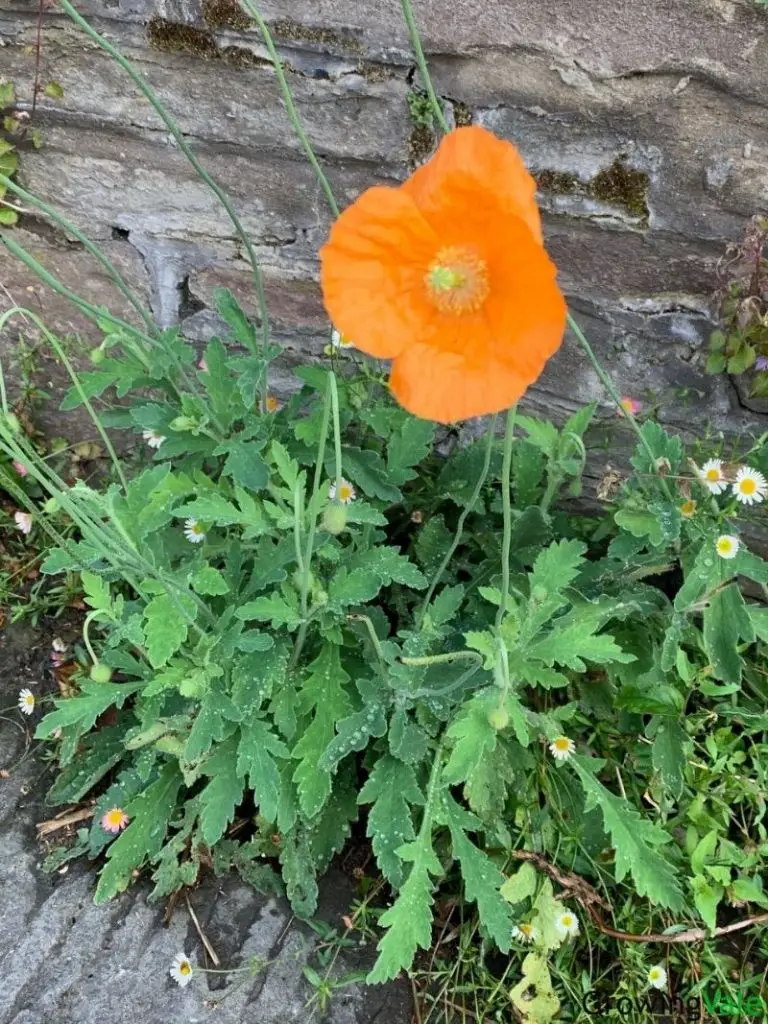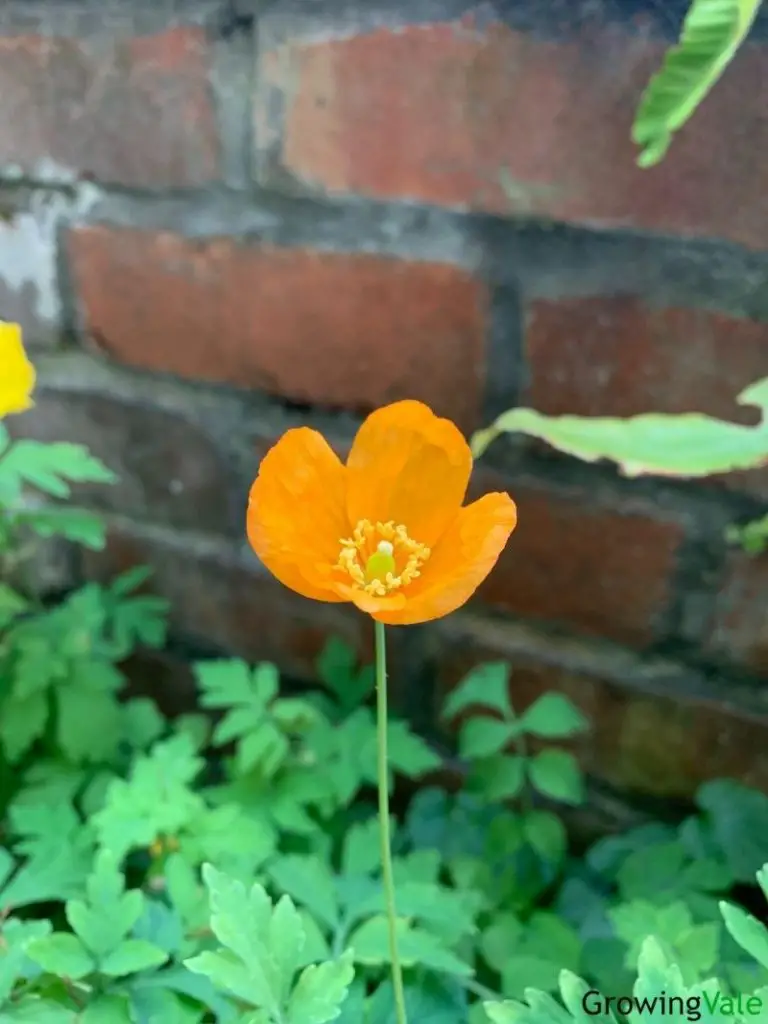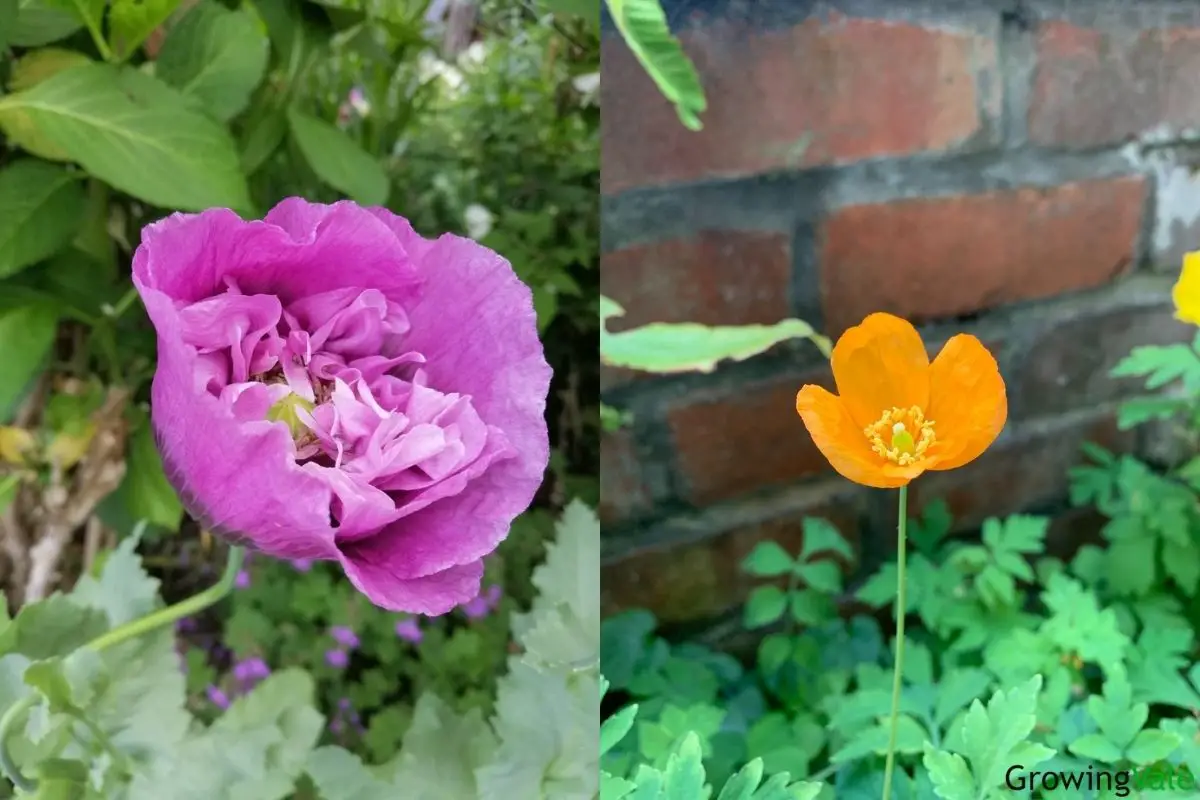Poppies are any flowering plants of the Papaveraceae family, which contains 44 genera and over 800 species, the most notable of which belong to the genus Papaver. Poppy flowers are very distinctive and both their blooms and seed capsules are easily recognized.
Poppy flowers are important symbols in today’s society, the California Poppy is the state flower of California and the Field Poppy is the national flower of Albania! The Field Poppy, which is sometimes called the Flanders Poppy, is also a hugely important symbol of World War I, where plants blanketed former battlegrounds.
They are particular favorites for cottage-style or wildflower meadow gardens. Blooms come in single, semi-double, and double forms, and in a range of colors! With such a large variety, whether you’re looking for an annual or perennial, for bold or delicate blooms, for bright or soft colors, you will find the right poppy types for you!

Beautiful Poppy Varieties to Plant in Your Garden
When it comes to growing poppies, here are different types of poppies you can choose:
#1 California Poppy (Eschscholzia californica)
The California Poppies are native to the western United States and Northern Mexico. Reaching heights of 12 inches, wild varieties have cream, pale-yellow or orange flowers. Blooms have four, rounded, silky petals, which overlap.
In cold winter climates, they can be grown as annuals, otherwise, they are perennials that will bloom every spring/summer. These flowers look very attractive when planted in big groups for a blanketing effect. Cultivars come in white, pink, and red.
#2 White Linen (E. califonica)
White Linen is a highly sought-after California Poppy cultivar. It grows to 12 inches tall and has fern-like foliage. T is named after its flowers which have four, overlapping, crisp-white petals and pronounced buttery-yellow stamens.
The white cup-shaped flowers almost seem to reflect out a rich, golden color, much like linens hanging in the sunshine. Grow as an annual in cold climates or a perennial in warm areas. These flowers fit perfectly in borders in rock or cottage-meadow gardens.
#3 Mexican Tulip Poppy (Hunnemannia fumariifolia)
Also known as the Golden Cup Poppy, this flower is native to southwestern North America. A popular ornamental plant, it is the only member of the genus Hunnemannia. Plants grow as tall as 20 inches with woody bases.
Cup-shape blooms reach as wide as 3 inches and have four, rounded sunshine-yellow petals and orange stamens. This sub-shrub has bluish-green foliage and is attractive to butterflies. It can be grown as a perennial in warm climates.
#4 Moroccan Poppy (P. atlanticum)

P. atlanticum originally comes from Morocco and Spain. It is a short-lived, clump-forming perennial species. They can grow up to 18 inches tall and prefer a Mediterranean climate.
These poppy flowers have a long blooming season and will add color to your garden from late spring to fall. Saucer-shaped blooms are 2.5 inches wide and have overlapping, dull orange petals. These low-maintenance plants are well suited to coastal or rock gardens.
#5 Welsh Poppy (P. cambricum)

This pretty little poppy plant is a perennial wildflower native to west and southwest Europe. It is also known as the Pyrenean poppy as it carpets the Pyrenees mountain meadows, and is the origin of the Basque saying “gold in the meadows”.
It grows 18 inches tall and produces numerous blooms. Flowers have silky, lemon-yellow petals (on occasion they can be orange too), and are a good choice to brighten up the garden! This poppy plant is hardy down to zone 6.
# 6 Iceland Poppy (P. nudicaule)
The Iceland or Arctic Poppy originates from Arctic North America and is a short-lived perennial plant hardy to zones 2-7. Normally grown as an annual, these upright plants reach heights of 12 inches.
Bowl-shaped flowers are fragrant with overlapping, papery-looking petals. Their bright yellow stamens form an attractive ring around the flower center. Blooms are reddish, orange, or yellow.
# 7 Champagne Bubbles Pink (P. nudicaule)
Champagne Bubbles Pink is part of the Champagne series. It is a beautiful Iceland Poppy variety that grows as tall as 15 inches. This is a short-lived perennial plant that will readily self-seed under the right conditions. Large, fragrant flowers are raspberry pink with softly crinkled petals. Stamens are delicate and golden yellow.
These lovely pink flowers would look perfect in the borders of cottage-style gardens, or scattered throughout wildflower meadow gardens. The blooms attract butterflies and bees, which is an added bonus!
#8 Bolero (P. orientale)
This magnificent poppy plant has large, cup-shaped, semi-double flowers. Petals are large, rosy-purple, and have lightly frilled edges with dark purple, almost black blotches at the center. They look fantastic when grouped together and will reach 30 inches when mature.
This is a perennial, hardy to zones 3-8, and will die back in winter leaving a void in the garden. Pair it with other perennials that will expand late during the season such as Baby’s Breath, so the gap between the foliage will be covered nicely.
#9 Eye Catcher (P. orientale)
Eye Catcher is a bold, clump-forming, perennial plant that will grow to a height of 36 inches. Its large blooms can reach 4-6 inches wide with numerous, crepe paper petals. Flowers have vivid orange-red, softly ruffled petals, dark central eyes, and dark stamens.
This bright and showy flower pairs well with late-season growers, which will expand to cover the hole left within the garden when it dies back for the winter. Consider pairing it with a compact Shasta Daisy variety in cottage-style gardens.
#10 Fancy Feathers (P. orientale)
A fantastic Oriental Poppy flower variety, Fancy Feathers is an eye-catching and lovely bloom for the garden! This perennial plant grows in clumps up to 15 inches wide and 24 inches tall. Its large flowers have a double form said to increase in fullness during the second year after planting. Petals are ruffled with fringed edges and are bold, raspberry pink.
Like other P. orientale poppies, this plant will die back leaving a gap in the garden. Plant it in small groups among expanding Dahlia’s of various pink, purple and orange shades for a beautiful and attractive display.
#11 Royal Wedding (P. orientale)
Royal Wedding grows as tall as 30 inches and is a clump-forming perennial poppy. It would be the highlight of any garden with its large, showy, and captivating flowers. The cup-shaped blooms have crepey, soft white petals with dark purple blotches around their dark center.
Stamens are purple to almost black, and flowers can be 4-6 inches across. This plant will die back over winter and would look very nice if planted among soft purple Russian Sage, which will expand to cover the space left inside the foliage.
#12 Field Poppy (P. rhoeas)
This poppy plant has many names (Field, Flanders, Common, Corn), and is easily the most recognizable poppy flower worldwide. It grows in clumps reaching 24 inches tall, spreading 12 inches wide, and has 3-4 inch flowers.
Blooms are commonly vibrant red but are sometimes pink or white. Rounded, crepe papery petals overlap and often have a dark central blotch. This species readily self-seeds, though it is considered a weed in some parts of Europe! Plant it in cottage-style or wildflower meadow gardens.
#13 Shirley Poppy (P. rhoeas)
The Shirley Poppy is a group of Poppies that were derived from P. rhoeas as early as 1880. They are easy-to-grow annuals and readily self-seed. Blooms are smaller than the Field
Poppy (2-3 inches) and come in single, semi-double, and double forms. They come in a wide variety of colors (pink, red, white, blue, purple, multi-colored, and even gray!), and look incredible when planted en masse in meadow-style gardens. They are often sold as mixed seed packets containing a selection of different Shirley Poppy types and colors that complement one another.
#14 Opium Poppy (P. somniferum)
P. somniferum is an attractive and showy poppy native to Turkey. It is an annual that grows between 3-5 feet tall. Flowers reach 5 inches across and are either purple-blue or white, with dark central blotches and light stamens. Petals have crinkled edges and a crepey appearance.
A hugely popular species, many ornamental double and semi-double varieties have been developed. However, Opium Poppies are not just beautiful garden flowers, they are also grown industrially for the production of poppy seeds and as an important component in the making of certain drugs.
#15 Danish Flag (P. somniferum)
Danish Flag is an unusual and vibrant flower. Petals are vivid red with white central blotches ringed with pale pink. Blooms have fringed petal edges and reach 5 inches wide. They are borne atop long stems which can grow up to 3 feet tall and have heart-shaped, silvery foliage. Stamens are numerous and pale pink. This is a good contender for rock and gravel gardens as well as for wildflower meadow styles.
#16 Pink Peony (P. somniferum)
Pink Peony is a delightful poppy flower! It closely resembles a Peony because it has a highly ruffled double form. Densely packed petals have a chiffon-like quality and are soft pink. Flowers grow as wide as 5 inches, whereas the plant itself reaches 4 feet in height. Leaves are heart-shaped and silvery-green.
Pink Peony is a great choice for cottage-style gardens, and its delicate pink color will greatly complement other cottage-style garden must-haves such as Hollyhocks and Foxgloves!
#17 Lilac Double Peony (P. somniferum)

Lilac Double Peony is another beautiful and showy Peony-type poppy that will be the center of attraction in any garden! Flowers have a double form, with extremely ruffled and densely packed petals.
These blooms are large, growing 5 inches across, and are a unique and pleasant shade of lilac-purple. Plants will reach 4 feet tall and spread 12 inches wide. Pair them with white-flowered plants to complement their vivid purple shade!
Reference list:
US Forest Service, California Poppy (Eschscholzia californica)
https://www.fs.fed.us/wildflowers/plant-of-the-week/eschscholzia_californica.shtml

